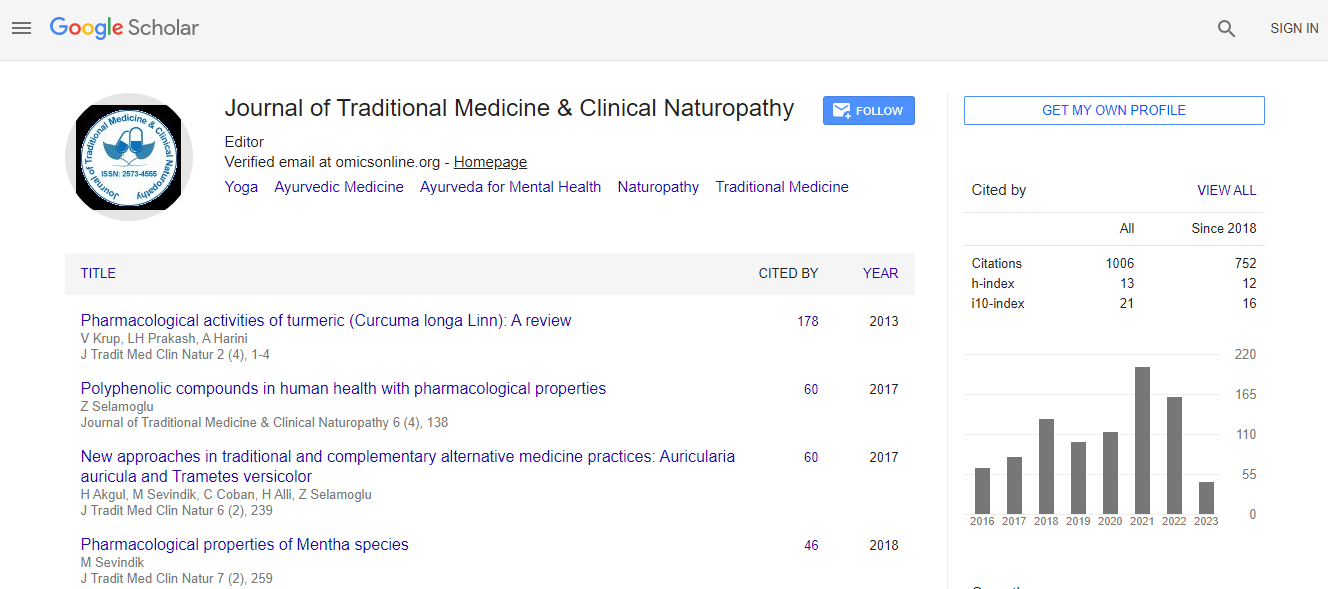Our Group organises 3000+ Global Conferenceseries Events every year across USA, Europe & Asia with support from 1000 more scientific Societies and Publishes 700+ Open Access Journals which contains over 50000 eminent personalities, reputed scientists as editorial board members.
Open Access Journals gaining more Readers and Citations
700 Journals and 15,000,000 Readers Each Journal is getting 25,000+ Readers
Google Scholar citation report
Citations : 1504
Journal of Traditional Medicine & Clinical Naturopathy peer review process verified at publons
Indexed In
- CAS Source Index (CASSI)
- Google Scholar
- Sherpa Romeo
- Open J Gate
- Genamics JournalSeek
- RefSeek
- Directory of Research Journal Indexing (DRJI)
- Hamdard University
- EBSCO A-Z
- Publons
- Geneva Foundation for Medical Education and Research
- Euro Pub
- ICMJE
Useful Links
Recommended Journals
Related Subjects
Share This Page
Implementation principle and animal study of analgesia using Great Needling
8th International Conference and Exhibition on Traditional & Alternative Medicine
Tong-Chien Wu
Chung Shan Medical University Hospital, Taiwan
ScientificTracks Abstracts: J Tradit Med Clin Natur
Abstract
Great Needling has been a way of acupuncture analgesia recorded in Huang Di Nei Jing. The principle “Pain up, needle down; and pain left, needle right” meaning the acupoint selection is far from the painful area, which is the main difference compared to general acupuncture. Therefore, this takes advantage in treating acute pain or around the lesion where acupuncture is not indicated. However, there is no specific description about the implementation in Huang Di Nei Jing and not in other later ancient literatures and the current studies of acupuncture analgesia using remote acupoint selection show inconsistent and even contradictory results. There are accumulating evidences surrounding the therapeutic effect of Electroacupuncture (EA). Transient Receptor Potential Vanilloid1 (TRPV1) and associated signaling pathways have been reported to be increased in inflammatory pain signaling. Local EA can reliably attenuate inflammatory pain and the increase of TRPV1 in mouse with unclear mechanisms. However, the effect of EA on distal and contralateral acupoint for pain control has been rarely studied and the result was controversial. Also, we developed Great Needling based on the theories of Same Name Meridians and Holographic Biology which are commonly adopted principles in clinical acupuncture treatment. We try to apply these methods in Great Needling with electroacupuncture to create a clear positioning theory of remote acupuncture analgesia and design further animal study assessing efficacy of analgesia with TRPV1. Here in our study, we found that inflammatory hindpaw pain in mouth, which was induced by injecting the Complete Freund’s Adjuvant (CFA), (2.65±0.34, p<0.05, n=6) for 2 days can be alleviated immediately after EA treatment (2 Hz, 15 minutes, 1 ma), (4.41±0.47, p<0.05, n=6) at contralateral forefoot acupoint LI4 through both mechanic and thermal behavior tests, while sham acupoint group is not. The efficacy was observed to be more obvious after the second round of EA treatment on the following day. The expression of TRPV1 and associated signaling pathways notably increased after the CFA injection; this expression can be further attenuated significantly in EA treatment. This analgesic effect is believed to be produced by applying EA to a site remote from the painful area based on Great Needling. The present study provides a powerful experimental animal model that can be used for investigating the unique physiological mechanisms involved in acupuncture analgesiaBiography
Tong-Chien Wu has received his MD cum laude from China Medical University and has been devoted to clinical practice in Traditional Chinese Medicine in Taiwan. He has completed Specialist degrees of Acupuncture Medicine and Traditional Chinese Internal Medicine. He is currently serving as an Attending Physician in Integrated Chinese and Western Medicine of Chung Shan Medical University Hospital. He has also completed his Master’s degree at Research Institute of Acupuncture Science in China Medical University. His expertise includes metabolic diseases and pain control.
E-mail: u9830018@cmu.edu.tw

 Spanish
Spanish  Chinese
Chinese  Russian
Russian  German
German  French
French  Japanese
Japanese  Portuguese
Portuguese  Hindi
Hindi 
